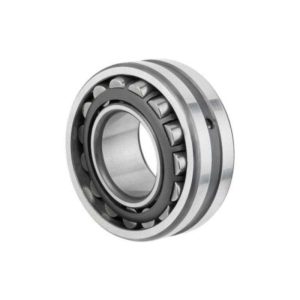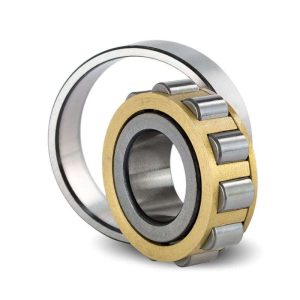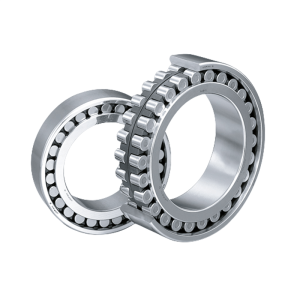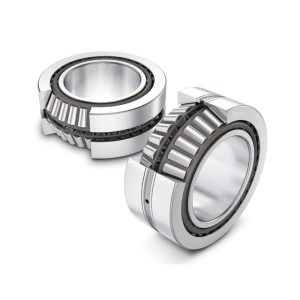Roller Bearings
Table of Contents
Definition
Definition
Roller bearings are mechanical components that reduce friction and promote smooth motion between two or more moving parts. They consist of cylindrical or tapered rollers fixed within a cage or assembly. These rollers distribute load evenly and enable controlled motion.

FHD Bearings is an ISO 9001:2015 certified manufacturing company. The enterprise specializes in the production of various series of spherical roller bearings, with a wide range of different sizes to meet customers’ needs.
Materials
-Steel is the most widely used material for roller bearings. Different types of steel, such as carbon steel, alloy steel, and stainless steel, are used based on the desired strength, corrosion resistance, and temperature tolerance.
–As FHD Bearing Company, stainless steel bearings are selected for their excellent corrosion and acid resistance, making them ideal for use in a variety of harsh environments, ensuring bearing reliability and long life.
– Roller bearings can also be made from various plastic materials, including polyamide (nylon), PTFE (Teflon), and others. Plastic roller bearings are often chosen for their lightweight and corrosion-resistant properties.
– As FHD Bearings, the main elements of our selection of plastic bearings are their lightweight, corrosion-resistant and self-lubricating properties, making them suitable for a wide range of applications, reducing friction and extending bearing life.

– Roller bearings used in applications requiring good heat dissipation and corrosion resistance may use bronze or brass cages. These materials are particularly useful in high-temperature environments.
– FHD Bearing Company understands that the advantages of selecting brass cages lie in their excellent thermal conductivity and corrosion resistance, which ensures that the bearings operate stably and maintain excellent performance under high temperatures and harsh environments.
Composite Materials
– Some roller bearings use composite materials, combining the advantages of different materials. These may include fiberglass-reinforced composites for improved strength and low weight.
-The choice of material for roller bearings depends on factors such as load capacity, speed, operating temperature, and the specific industry or application.FHD Bearing, as a specialized manufacturer of bearings, can provide a range of roller bearings designed with the appropriate materials to meet the needs of your industry and application.
Features

- Low friction (Roller end / flange contact area)
The open flange design , together with the roller end design and surface finish, promote lubricant film formation resulting in lower friction and higher axial load carrying capacity.
- Long service life
The logarithmic roller profile reduces edge stresses at the roller/raceway contact and sensitivity to misalignment and shaft deflection.
- Enhanced operational reliability
The surface finish on the contact surfaces of the rollers and raceways supports the formation of a hydrodynamic lubricant film.
- Separable and interchangeable
The separable components of FHD cylindrical roller bearings are interchangeable. This facilitates mounting and dismounting, as well as maintenance inspections.
- High speed capability
The cage designs are suitable for high speeds, rapid accelerations and peak loads.
Advantages
- High Load-Carrying Capacity: Roller bearings are designed to distribute loads over a larger area, enabling them to carry higher radial and axial loads compared to ball bearings.
- Durable and Long-Lasting: Roller bearings are built to withstand heavy loads and are more resistant to wear and deformation, contributing to their long service life.
- High Radial Precision: Roller bearings are known for their high radial precision, making them suitable for applications where precise shaft positioning is critical.
- Versatility: They come in various designs, including cylindrical, tapered, spherical, and needle rollers, allowing them to be used in a wide range of applications.
- Operational Stability: Roller bearings are designed for smooth and stable operation, even under high loads and varying conditions.
- Temperature Tolerance: Roller bearings can often operate in higher temperature environments without compromising their performance.
- Easy Maintenance: They are relatively easy to maintain and replace when necessary, reducing downtime.

Taxonomy
Cylindrical Roller Bearings

Single Row Cylindrical Roller Bearings
The single row bearings comprise solid outer rings, inner rings and cages that are fitted with a large number of cylindrical rollers.

Single Row Cylindrical Roller Bearings
The single row bearings comprise solid outer rings, inner rings and cages that are fitted with a large number of cylindrical rollers.

Double Row Cylindrical Roller Bearings
These bearings are suitable for heavy radial loads.along with a higher axial load carrying capacity and a high speed capability.
Thrust Roller Bearings

Single Row Cylindrical Roller Thrust Bearings
Single row thrust cylindrical roller bearings are specialized bearings designed to accommodate axial loads, making them a crucial component in applications where forces are primarily directed along the bearing's axis.

Thrust Roller Bearings
Spherical roller thrust bearings is a rolling-element bearing of thrust type and it have specially designed raceways and asymmetrical rollers.it permits rotation with low friction,and permits angular misalignment.Bearings can withstand axial loads acting in one.

Thrust Roller Bearings
Spherical roller thrust bearings are specialized bearings that can handle high axial loads, misalignment, and shaft deflection, making them ideal for heavy machinery and equipment.
Spherical Roller Bearings

Double Row Spherical Roller Bearings
Double Row Spherical Roller Bearings are designed to work in applications where severe misalignment exists whether from mounting or shaft deflection and with relatively heavy radial loads and some axial loads in either direction.

Double Row Spherical Roller Bearings
Spherical roller bearings are a type of rolling-element bearing known for their ability to accommodate both radial and axial loads while compensating for misalignment. They are widely used in various industries and applications.
Tapered Roller Bearings

Single Row Tapered Roller Bearing
Single row tapered roller bearings are designed to accommodate combined loads,i.e.simultaneously acting radial and axial loads. This series contains(Bearings,Cones,Cups) three combinations can be selected.

Double Row Tapered Roller Bearing
Double row tapered roller bearings designs, in many variants and with different features. These bearings can accommodate heavy radial loads,axial loads in both directions and have a high degree of stiffness This series contains Bearings.
Needle Roller Bearings

Needle Roller Thrust Bearings
Washers allow you to use the bearing on unhardened and unground surfaces.Needle roller cages require ground and hardened surfaces as raceways, have a low axial section height and can support axial forcesin one direction.
Applications

- Automotive: Roller bearings are used in automotive applications, including wheel bearings, transmission systems, and engine components, where they provide smooth and efficient rotation.
- Aerospace: They play a critical role in aircraft landing gear, engine systems, and flight control mechanisms, ensuring reliable and precise operation.
- Manufacturing: Roller bearings are used in conveyor systems, machine tools, and manufacturing equipment to support and guide moving parts, reducing friction and wear.
- Construction and Heavy Machinery: These bearings are employed in construction equipment such as excavators, cranes, and bulldozers to handle heavy loads and maintain operational efficiency.
- Agriculture: Roller bearings are found in agricultural machinery like tractors, combines, and harvesters, ensuring the smooth operation of moving parts.
- Railway Industry: They are used in train wheels and axles to provide reliable and low-friction performance, contributing to the safe and efficient operation of trains.
- Mining: In mining equipment such as crushers, conveyors, and vibrating screens, roller bearings help handle heavy loads and harsh conditions, improving equipment reliability.
- Marine: In marine applications, roller bearings are utilized in ship propulsion systems, winches, and anchor handling machinery, providing dependable performance in saltwater environments.
- Energy and Power Generation: Roller bearings are used in turbines, generators, and other power generation equipment, helping reduce friction and maintain efficiency.
- Medical Equipment: In medical devices such as MRI machines and X-ray equipment, roller bearings contribute to precise and smooth movements.
- Food and Beverage Industry: Roller bearings are employed in conveyors and processing equipment, ensuring hygienic and efficient material handling.
- Textile Industry: In textile machinery like looms and spinning frames, roller bearings are used to maintain consistent movement and minimize downtime.
Key Manufacturing Processes For Roller Bearings
Raw Material Preparation
Material Selection: The process begins with selecting the appropriate materials for the inner and outer rings, rollers, and the cage (if applicable). Common materials include steel, ceramic, and plastic, chosen based on the bearing’s intended use.
Forging or Turning: The selected materials are typically forged or turned to create the basic shapes of the inner and outer rings, which are then heat-treated for enhanced hardness and strength.
Forming Process
Roller Formation: Rollers are shaped from cylindrical stock material through processes like cold-forming or machining. The rollers are also heat-treated to optimize their hardness and durability.
Cage Manufacturing: If the bearing design requires a cage to separate and guide the rollers, cages are fabricated using processes like stamping, molding, or precision machining. Various materials, including steel, brass, and plastic, are used for cages.
Abrasive Processing
Grinding: The components are precision-ground to ensure precise dimensions and a smooth, low-friction surface finish. This step is crucial for achieving high radial and axial accuracy.
Sintering
Heat Treatment: All bearing components, including the inner and outer rings, rollers, and cage, undergo heat treatment processes to achieve the desired hardness, toughness, and microstructure for longevity and load-carrying capacity.
Post-Sintering Operations
Assembly: The individual components (inner and outer rings, rollers, and cage) are assembled together to create the bearing assembly. The assembly process may involve using adhesives, snap rings, or interference fits to hold the components together.
Lubrication: The bearings are lubricated with grease or oil to reduce friction and wear between the moving parts. The choice of lubricant depends on the bearing’s application and operating conditions.
Quality Control: Rigorous quality control and inspection processes are conducted to check for dimensional accuracy, smooth operation, and any defects. This ensures that only high-quality bearings reach the market.
Packaging and Distribution: After successful inspection and quality control, the bearings are packaged for distribution to customers. Proper packaging helps protect the bearings from contamination and damage during shipping and storage.



FAQ - Frequently Asked Questions

A roller bearing is a mechanical component used to reduce friction and support axial or radial loads by employing cylindrical or barrel-shaped rollers.
Common types include cylindrical, tapered, spherical, needle, and thrust roller bearings, each designed for specific applications.
Roller bearings use cylindrical or tapered rollers, while ball bearings use spherical balls. Rollers have a larger contact area, allowing them to handle heavier loads.
Roller bearings offer high load capacity, reduced friction, and the ability to handle both radial and axial loads, making them versatile and reliable.
Roller bearings are used in automotive, aerospace, manufacturing, construction, mining, and many other industries.
A roller bearing typically consists of inner and outer rings, rollers, and, in some cases, a cage to separate and guide the rollers.
Roller bearings have rolling elements that distribute loads over a larger contact area, reducing friction and wear.
The cage holds the rollers in position, preventing them from coming into contact and maintaining proper spacing.
Sealed bearings are pre-lubricated and enclosed to keep contaminants out, while open bearings require external lubrication.
Roller bearings are lubricated with oil or grease to reduce friction, prevent wear, and dissipate heat generated during operation.
Load type and magnitude, speed, temperature, environmental conditions, and desired service life are key factors to consider.
The load capacity depends on bearing size and type. Manufacturers provide load ratings for specific bearings.
Radial load is a force acting perpendicular to the bearing’s axis, while axial load is a force acting along the bearing’s axis.
Mounting and dismounting procedures may vary by bearing type; follow manufacturer guidelines for proper installation and removal.
Regular lubrication, monitoring for signs of wear or damage, and keeping bearings clean can extend their lifespan.
Common causes of failure include insufficient lubrication, contamination, misalignment, and overload. Regular maintenance and proper installation can prevent failure.
Yes, roller bearings can be designed to operate in high-temperature environments with appropriate materials and lubrication.
Single-row bearings have one set of rollers, while double-row bearings have two sets, offering higher load capacity and rigidity.
Store bearings in a cool, dry place, away from direct sunlight and corrosive substances. Rotate stored bearings regularly to prevent flat spots.
You can find standards and specifications from organizations like the American Bearing Manufacturers Association (ABMA) and the International Organization for Standardization (ISO).
Installation and Maintenance
Roller Bearings Installation
- Cleanliness is Key: Ensure that the installation area is clean and free from any contaminants. Clean the bearing housing and shaft thoroughly.
- Check Tolerances: Verify that the bearing’s internal and external diameters are within the specified tolerances to prevent any interference fit issues.
- Proper Lubrication: Lubricate the bearing and mating surfaces with an appropriate lubricant to reduce friction and prevent premature wear.
- Align the Bearings: Ensure precise alignment of the bearings on the shaft to prevent misalignment issues that can lead to bearing failure.
- Appropriate Tools: Use the right tools and equipment to avoid damaging the bearing during installation. Specialized tools like bearing heaters may be necessary.
- Avoid Over-Tightening: Be cautious not to over-tighten the bearings, as this can cause excessive preload and reduce bearing life.
- Check Temperature: Monitor the temperature during the mounting process. Excessive heat can damage the bearing. Use temperature control techniques as needed.
- Verify Fit: After mounting, double-check the fit to make sure the bearing operates smoothly and with the correct clearance.
Maintenance:
- Regular Inspections: Implement a routine inspection schedule to detect early signs of wear or damage. This can prevent unexpected failures.
- Lubrication Management: Maintain proper lubrication by following manufacturer-recommended intervals and using the right lubricants. Consider automatic lubrication systems for efficiency.
- Environmental Conditions: Ensure that bearings are protected from harsh environmental conditions like dust, moisture, and extreme temperatures. Seals and shields may be required.
- Re-lubrication: When necessary, re-lubricate the bearings in accordance with recommended guidelines. Avoid over-lubrication, as it can lead to overheating.
- Vibration Analysis: Implement vibration analysis to detect irregularities in bearing performance. This can help in predictive maintenance.
- Replacement: When bearings show signs of significant wear or damage, replace them promptly. Use high-quality replacement bearings.
- Training: Train your maintenance personnel in proper handling and maintenance procedures to ensure consistent practices.

Related Posts
Cylindrical Roller Thrust Bearings 101: Mastering the Basics
Table of Contents Categories Cylindrical Roller Thrust Bearings 101: Mastering...
Read MoreRevolutionize Your Machinery: Needle Roller Thrust Bearing Insights
Table of Contents Categories Revolutionize Your Machinery: Needle Roller Thrust...
Read MoreHow To Achieve Optimal Bearing Lubrication
Table of Contents Categories How To Achieve Optimal Bearing Lubrication...
Read MoreTapered Roller Bearings: Precision Beyond Measure
Table of Contents Categories Tapered Roller Bearings: Precision Beyond Measure...
Read More



